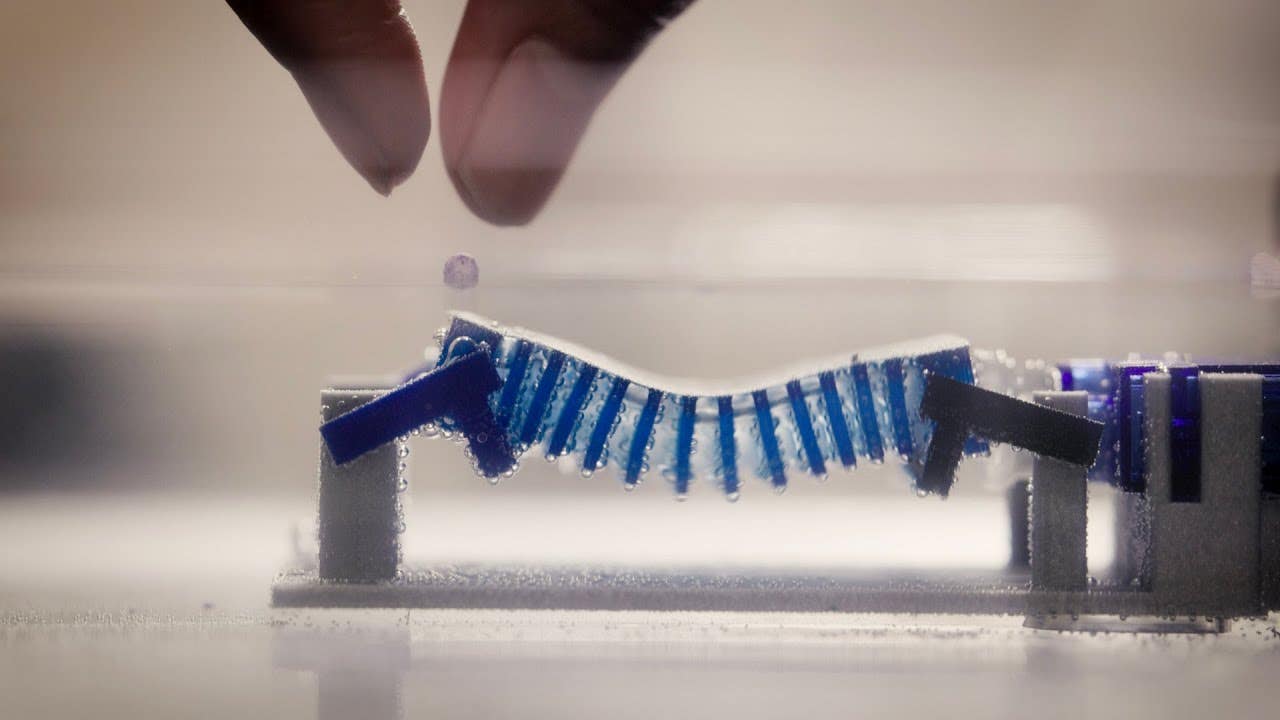Snail-Inspired Robot Takes on Ocean Microplastic Cleanup
Scientists have drawn inspiration from the humble Hawaiian apple snail to develop a pioneering robot to combat the menace of microplastics

[Dec. 12, 2023: JD Shavit, The Brighter Side of News]
With plastic pollution reaching alarming levels in marine environments, this discovery could herald a new era in ecological restoration. (CREDIT: Naja Bertolt Jensen.)
In a remarkable fusion of nature and technology, scientists have drawn inspiration from the humble Hawaiian apple snail to develop a pioneering robot prototype designed to combat the menace of microplastics in our planet's water bodies. With the potential to revolutionize how we address this pressing environmental issue, this innovative creation promises to play a crucial role in safeguarding our oceans, seas, and lakes.
The concept behind this groundbreaking robotic design is rooted in the unique abilities of the Hawaiian apple snail, scientifically known as Pomacea canaliculata. This common aquarium-dwelling snail possesses a remarkable method for capturing floating food particles through the undulating motion of its foot. It utilizes this undulating action to create water surface flow, effectively vacuuming up food particles suspended on the water's surface.
At present, most plastic collection devices predominantly rely on drag nets or conveyor belts to corral and remove larger plastic debris from water bodies. However, these methods fall short when it comes to the critical task of retrieving microplastics, which are minuscule particles of plastic pollution. These tiny plastic fragments pose a significant threat to marine life as they can be ingested by organisms and subsequently enter the food chain, with potential repercussions for human health due to their carcinogenic properties.
Professor Sunghwan "Sunny" Jung, a leading expert in the field and a member of the Department of Biological and Environmental Engineering at Cornell University, spearheaded this pioneering research. He drew inspiration from the snail's efficient feeding mechanism, which operates at the interface between air and water.
Related Stories
Professor Jung is the senior author of the research study titled "Optimal free-surface pumping by an undulating carpet," published in the prestigious scientific journal Nature Communications.
The ingenious prototype developed by the research team is an adaptation of an existing design, representing a crucial step toward a practical solution for microplastic cleanup. To create this innovative device, a 3D printer was employed to produce a flexible, carpet-like sheet with the capacity for undulating motion. Underneath this sheet lies a helical structure that rotates in a manner akin to a corkscrew, inducing undulation and generating a traveling wave on the water's surface.
An essential aspect of this groundbreaking research was the meticulous analysis of fluid dynamics. Professor Jung emphasized the importance of comprehending the intricate fluid flow patterns, stating, "We needed to understand the fluid flow to characterize the pumping behavior." Unlike conventional closed-system pumps that require a tube to draw in water and particles, the snail-inspired open system proves to be far more efficient. Remarkably, the small prototype operates on a mere 5 volts of electricity while efficiently drawing in water.
However, owing to the additional weight of a battery and motor, the researchers acknowledge the need to attach a flotation device to the robot to prevent it from sinking in real-world deployment.
The study's first author, Anupam Pandey, formerly a postdoctoral researcher in Professor Jung's lab and currently an assistant professor of mechanical engineering at Syracuse University, has been at the forefront of this groundbreaking research.
As humanity grapples with the escalating crisis of plastic pollution in our oceans and water bodies, innovative solutions like the snail-inspired robot offer a glimmer of hope. These microscopic plastic fragments, often invisible to the naked eye, have infiltrated every corner of our aquatic ecosystems. Microplastics pose not only an ecological threat but also a direct health risk to humans as they accumulate in the marine food chain.
Traditional methods of plastic cleanup, such as nets and conveyor belts, have proven ineffective when dealing with these minute particles. Consequently, scientists have turned to nature for inspiration, seeking solutions rooted in the elegant designs perfected by millions of years of evolution. In the case of the Hawaiian apple snail, its ingenious feeding mechanism became a source of inspiration that may revolutionize the fight against microplastic pollution.
The Hawaiian apple snail's method of capturing floating food particles through undulating motions of its foot at the water's surface serves as a testament to nature's remarkable efficiency. This unique adaptation has now been harnessed to engineer a device that holds the potential to extract microplastics from oceans, seas, and lakes. By closely mimicking the snail's approach, scientists aim to address the dire need for a practical and efficient solution to microplastic pollution.
One of the primary challenges of microplastic cleanup is the development of a method that can operate effectively at the water's surface while ensuring the removal of these minuscule plastic particles. Traditional plastic collection devices are designed to target larger plastic debris and are ill-suited to capturing microplastics, which often float near the surface and elude conventional means of retrieval.
The newly developed robot prototype, inspired by the Hawaiian apple snail, marks a significant step toward solving this problem. While the prototype is currently small in scale, its potential to make a substantial impact on microplastic cleanup is undeniable. The robot utilizes a 3D-printed, flexible sheet that mimics the snail's undulating foot motion, creating a traveling wave on the water's surface.
The success of this innovation hinges on the fluid dynamics at play. To replicate the snail's effective feeding mechanism, the research team meticulously studied the fluid flow patterns. They discovered that the snail's open-system approach, which operates at the air-water interface, offered unparalleled efficiency compared to closed systems. While a closed system would require high-energy inputs to operate, the snail-inspired open system operates efficiently, drawing in water and particles with minimal energy consumption.
Notably, the robot prototype consumes a mere 5 volts of electricity, making it an energy-efficient solution for microplastic cleanup. However, to ensure its practicality in real-world scenarios, the researchers are exploring the possibility of attaching a flotation device to the robot to prevent it from sinking due to the added weight of a battery and motor.
Professor Sunny Jung, the visionary behind this research, envisions a future where robots inspired by nature's efficiency play a pivotal role in mitigating the impact of microplastics on our ecosystems. He emphasizes that understanding and harnessing the principles of fluid dynamics, as demonstrated by the Hawaiian apple snail, offer promising avenues for innovative solutions to pressing environmental challenges.
As we grapple with the alarming proliferation of microplastics in our oceans, seas, and lakes, it is imperative that we continue to explore novel approaches rooted in the natural world. The snail-inspired robot prototype serves as a testament to the power of biomimicry—a practice that draws inspiration from nature's intricate designs to solve complex human problems.
Sunny Jung, professor of biological and environmental engineering (far right) and study coauthors (from left), Jisoo Yuk, Chris Roh and Yicong Fu, watch a demonstration of their snail-inspired robot. (CREDIT: Cornell University)
While the prototype is currently in the early stages of development, its potential to revolutionize microplastic cleanup cannot be overstated. With further refinement and scaling up, this innovation could become a game-changer in our ongoing battle against plastic pollution.
As we look toward the future, it is essential that we continue to harness the brilliance of nature's designs to address the environmental crises that threaten our planet. The Hawaiian apple snail has shown us the way, and with innovative technologies like this robot prototype, we can work towards a cleaner, healthier, and more sustainable world for generations to come.
For more environmental news stories check out our Green Impact section at The Brighter Side of News.
Note: Materials provided above by The Brighter Side of News. Content may be edited for style and length.
Like these kind of feel good stories? Get the Brighter Side of News' newsletter.
Joshua Shavit
Science & Technology Writer | AI and Robotics Reporter
Joshua Shavit is a Los Angeles-based science and technology writer with a passion for exploring the breakthroughs shaping the future. As a contributor to The Brighter Side of News, he focuses on positive and transformative advancements in AI, technology, physics, engineering, robotics and space science. Joshua is currently working towards a Bachelor of Science in Business Administration at the University of California, Berkeley. He combines his academic background with a talent for storytelling, making complex scientific discoveries engaging and accessible. His work highlights the innovators behind the ideas, bringing readers closer to the people driving progress.



